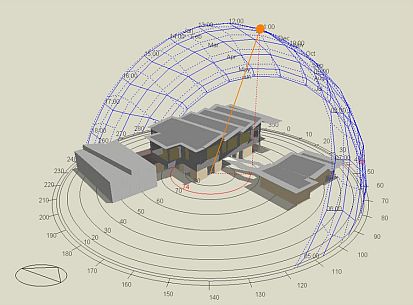Commercial Services
Section J Assessment & Report
Comprehensive Section J Assessments for Energy Efficiency Compliance
At Efficient Living, we provide detailed and compliant Section J reports to ensure your non-residential buildings (Class 3, 5, 7, 8, and 9) meet the rigorous energy efficiency standards set by Volume One of the National Construction Code (NCC). It focuses on reducing the energy consumption of new and existing buildings, contributing to the country’s broader sustainability goals. Section J covers various elements, including building fabric, glazing, sealing, air conditioning, ventilation, artificial lighting, power, hot water supply, and access for maintenance.
How Section J is Assessed
Efficient Living employs both Deemed-to-Satisfy (DTS) provisions and JV3 (J1V3 under NCC 2022) verification methodology to ensure your building meets all NCC requirements.
A DTS assessment is always the first step in Efficient Living’s National Construction Code (NCC) Section J energy efficiency assessment service. A DTS assessment sets out the minimum glazing and insulation requirements for commercial buildings and communal areas in residential buildings. Proof of compliance with Section J is generally required at the construction certificate stage. It is however advised that a preliminary glazing calculator is completed pre-development application as the results may influence design in terms of glass size, location and shading structure design.
Efficient Living’s Section J compliance reports are laid out in an easy-to-follow table with insulation plan markups and accompanying NCC glazing tables.

Section J JV3 Alternative Solution
The National Construction Code allows a JV3 (J1V3 under NCC 2022) Alternative Solution for commercial buildings. JV3 allows much more flexibility with regards to design and specification. Efficient Living uses DesignBuilder to model commercial buildings under the JV3 policy when the DTS solution is not deemed appropriate.
DesignBuilder incorporates the EnergyPlus simulation engine which predicts building greenhouse gas emissions and occupant thermal comfort.
Commercial energy efficiency performance targets are far more stringent than the baseline for the residential sector so it makes sense to rely on detailed modelling to inform the design process for these building classes.

NABERS Rating Assessment
NABERS (National Australian Built Environment Rating System) is a trusted, nationally recognized system that provides an in-depth evaluation of a building’s sustainability across several key areas, including energy, water, indoor environment, and waste management. Efficient Living offers comprehensive NABERS Rating Assessment services to help building owners and managers accurately measure and enhance the environmental performance of their properties.
The NABERS Rating Process: How It Works
At Efficient Living, we guide you through the NABERS rating process, providing a clear and reliable measure of your building’s operational performance over a 12-month period.
- Data Collection: We gather verified real-world performance data, such as utility and water bills, to assess your building’s energy and water usage.
- Performance Analysis: The collected data is analyzed and compared against benchmarks for similar buildings in your area. This helps determine how efficiently your building is operating.
- Star Rating Conversion: The performance data is converted into an easy-to-understand star rating system, ranging from one star (indicating significant room for improvement) to six stars (representing industry-leading performance).
- Final Rating: You receive a NABERS star rating that reflects your building’s actual operational performance, providing a clear indication of where your building stands in terms of sustainability and efficiency.
Why Choose a NABERS Rating?
- Benchmark Performance: Understand how your building compares to others in the same area.
- Identify Improvement Areas: Highlight specific areas where efficiency can be enhanced.
- Showcase Excellence: Achieve a high star rating to demonstrate leadership in sustainability and operational performance.
Let Efficient Living help you navigate the NABERS rating process and achieve the highest standards of efficiency and sustainability for your building.
NABERS Commitment Agreements
Efficient Living’s NABERS Commitment Agreements service is designed to help building owners and developers commit to future sustainability targets and achieve exceptional environmental performance over time. NABERS Commitment Agreements are formal agreements that set clear, measurable sustainability goals to be reached within a specified timeframe, typically during the design, construction, or refurbishment stages.
Our NABERS Commitment Agreements service begins with the preparation and formalization of a commitment agreement that clearly defines the sustainability targets for the project. We work closely with clients to set realistic yet ambitious goals for energy efficiency. This service ensures that sustainability objectives are integrated into the early stages of building development, leading to more efficient, environmentally friendly buildings that are prepared to meet future standards.
How a NABERS Commitment Agreement is Lodged
Lodging a NABERS Commitment Agreement involves a structured process that ensures the sustainability targets for a building are formally recognized and can be tracked over time. Here’s a detailed outline of the steps involved in lodging a NABERS Commitment Agreement:
- Initial Consultation and Feasibility Study: We begin by engaging with the client to understand the project’s scope, sustainability goals, and requirements. We conduct a preliminary assessment to estimate the potential NABERS rating and outline the necessary steps to achieve the desired performance targets.
- Setting Performance Targets: Collaborating with the client, we establish realistic and achievable NABERS targets based on the feasibility study, aligned with the client’s sustainability objectives.
- Lodging the Agreement: An accredited NABERS Assessor reviews the project plans, ensuring proposed measures meet NABERS standards. We then submit the documentation, including the Commitment Agreement form, project details, and intended NABERS rating, to the NABERS Administrator.
- Review and Approval: The NABERS Administrator reviews the submitted documents, ensuring they meet the criteria and proposed measures are adequate. Upon satisfactory review, the Commitment Agreement is approved, and certification is issued, confirming the building’s commitment to achieving the specified NABERS rating.
- Implementation and Monitoring: During design and construction, all measures specified in the Commitment Agreement are implemented. We continuously monitor progress to ensure the project stays on track, conducting regular site inspections and performance tracking.
Submit the final assessment report to the NABERS Administrator to obtain the official NABERS rating for the building.
By following these steps, a NABERS Commitment Agreement ensures that a building is designed, constructed, and operated to meet high sustainability standards, ultimately achieving the desired NABERS rating and demonstrating a firm commitment to environmental performance.
Green Star
What is Green Star?
Green Star is Australia’s trusted mark of quality for the design, construction, and operation of healthy, resilient, and positive buildings. It encourages practices that reduce the impact of climate change, enhance health and quality of life, restore and protect biodiversity and ecosystems, drive resilient outcomes, and contribute to a sustainable economy.
Key Aspects of Green Star Ratings:
- Green Star – Buildings: This rating tool assesses the sustainability of a project from the design phase through to construction. Green Star – Design & As Built is the older version for Greens Star Buildings.
- Green Star – Interiors: Focuses on the sustainability of interior fit-outs in existing buildings.
- Green Star – Performance: Measures the operational performance of existing buildings.
- Green Star – Communities: Evaluates the planning, design, and construction of large-scale development projects.
The Green Star Certification Process:
- Initial Consultation and Feasibility Study: We begin by understanding your project’s scope, sustainability goals, and requirements. We conduct a preliminary assessment to determine the potential Green Star rating your project can achieve and identify the necessary steps to reach the desired performance targets.
- Setting Performance Targets: Based on the feasibility study, we work with you to establish realistic and achievable Green Star targets that align with your sustainability objectives.
- Lodging the Agreement: Our accredited Green Star professionals review your project plans to ensure they align with Green Star standards. We then compile and submit the necessary documentation, including the completed certification application and project details, to the Green Building Council of Australia (GBCA).
- Review and Approval: The GBCA reviews the submitted documents to ensure they meet the required criteria and that the proposed measures are feasible to achieve the target rating. Upon satisfactory review, the GBCA approves the certification and issues a preliminary rating.
- Implementation and Monitoring: During the design and construction phases, we implement all the measures specified to achieve the target performance. We continuously monitor the project’s progress, conduct regular site inspections, track performance, and make adjustments as necessary.
- Final Assessment and Rating: Once the building is operational, we conduct a final assessment to verify that it meets the performance targets outlined. The GBCA then reviews the final documentation and issues the official Green Star rating.
Why Choose Efficient Living for Green Star Certification?
With over 20 years of experience in the sustainability domain, Efficient Living provides customized consulting tailored to each project’s unique requirements. Our team of senior consultants ensures high standards are maintained throughout the certification process. We are dedicated to helping you create buildings that perform at their best, delivering tangible benefits to the environment and the occupants within a range of budgets and sustainability appetites.
Get Started with Efficient Living
Contact us today to learn how we can assist you in achieving Green Star certification and making a positive impact on the built environment. Let’s work together to create a sustainable future
Onsite Compliance
The Energy Efficiency framework in Australia revolves around buildings in the design stage. The As Built outcomes delivered to homeowners is not always as promised in early stage documentation.
There is now a lot of work being done to further educate certifiers and builders to improve build quality. In NSW, following the final inspection and prior to issuing a final occupation certificate, the certifying authority is required to issue a BASIX completion receipt. It is now becoming more common for certifiers of multi-residential and commercial building projects to request the final check to be completed by an independant Qualified Assessor rather than the builder.
Efficient Living provides this service to further support our building clients, reduce their liabilities and improve quality control. We aim to make the compliance process as easy as possible by providing installation certification documents for our clients to distribute to all relevant trades, complete the site inspections as required to ensure the building complies with Section J, Energy Efficiency of the National Construction Code (NCC).
Beautifully designed and specified buildings make our home and workspace more enjoyable. We thrive in bright, fresh and healthy environments. Businesses recognise the effect of indoor air quality on staff productivity and retention. Efficient Living understands sustainability has moved beyond energy efficiency and is now all about LIVABILITY.





























